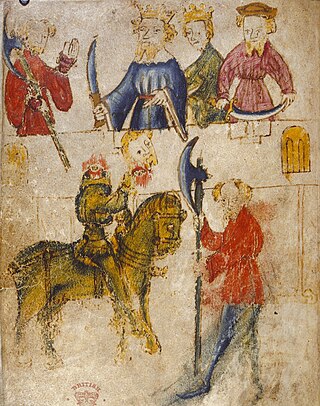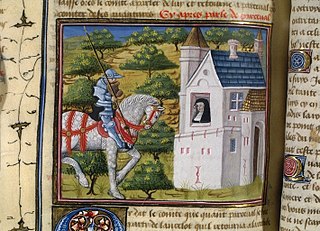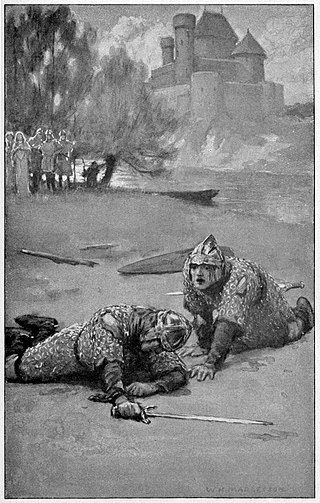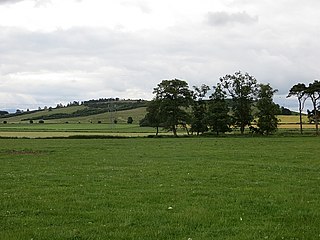Related Research Articles

Sir Gawain and the Green Knight is a late 14th-century chivalric romance in Middle English alliterative verse. The author is unknown; the title was given centuries later. It is one of the best-known Arthurian stories, with its plot combining two types of folk motifs: the beheading game, and the exchange of winnings. Written in stanzas of alliterative verse, each of which ends in a rhyming bob and wheel, it draws on Welsh, Irish, and English stories, as well as the French chivalric tradition. It is an important example of a chivalric romance, which typically involves a hero who goes on a quest which tests his prowess. It remains popular in modern English renderings from J. R. R. Tolkien, Simon Armitage, and others, as well as through film and stage adaptations.

Gawain, also known in many other forms and spellings, is a character in Arthurian legend, in which he is King Arthur's nephew and one of the premier Knights of the Round Table. The prototype of Gawain is mentioned under the name Gwalchmei in the earliest Welsh sources. He has subsequently appeared in many Arthurian tales in Welsh, Latin, French, English, Scottish, Dutch, German, Spanish, and Italian, notably as the protagonist of the Middle English poem Sir Gawain and the Green Knight. Other works featuring Gawain as their central character include De Ortu Waluuanii, Diu Crône, Ywain and Gawain, Golagros and Gawane, Sir Gawain and the Carle of Carlisle, L'âtre périlleux, La Mule sans frein, La Vengeance Raguidel, Le Chevalier à l'épée, Le Livre d'Artus, The Awntyrs off Arthure, The Greene Knight, and The Weddynge of Syr Gawen and Dame Ragnell.

Mordred or Modred is a figure in the legend of King Arthur. The earliest known mention of a possibly historical Medraut is in the Welsh chronicle Annales Cambriae, wherein he and Arthur are ambiguously associated with the Battle of Camlann in a brief entry for the year 537. Medraut's figure seemed to have been regarded positively in the early Welsh tradition and may have been related to that of Arthur's son.

The Knights of the Round Table are the legendary knights of the fellowship of King Arthur that first appeared in the Matter of Britain literature in the mid-12th century. The Knights are an order dedicated to ensuring the peace of Arthur's kingdom following an early warring period, entrusted in later years to undergo a mystical quest for the Holy Grail. The Round Table at which they meet is a symbol of the equality of its members, who range from sovereign royals to minor nobles.

The Green Knight is a heroic character of the Matter of Britain, originating in the 14th-century poem Sir Gawain and the Green Knight and the related medieval work The Greene Knight. His true name is revealed to be Bertilak de Hautdesert in Sir Gawain, while The Greene Knight names him "Bredbeddle". The Green Knight later features as one of Arthur's greatest champions in the fragmentary ballad "King Arthur and King Cornwall", again with the name "Bredbeddle".

Gaheris is a Knight of the Round Table in the chivalric romance tradition of Arthurian legend. A nephew of King Arthur, Gaheris is the third son of Arthur's sister or half-sister Morgause and her husband Lot, King of Orkney and Lothian. He is the younger brother of Gawain and Agravain, the older brother of Gareth, and half-brother of Mordred. His figure may have been originally derived from that of a brother of Gawain in the early Welsh tradition, and then later split into a separate character of another brother, today best known as Gareth. German poetry also described him as Gawain's cousin instead of brother.

Perceval, the Story of the Grail is the unfinished fifth verse romance by Chrétien de Troyes, written by him in Old French in the late 12th century. Later authors added 54,000 more lines to the original 9,000 in what are known collectively as the Four Continuations, as well as other related texts. Perceval is the earliest recorded account of what was to become the Quest for the Holy Grail but describes only a golden grail in the central scene, does not call it "holy" and treats a lance, appearing at the same time, as equally significant. Besides the eponymous tale of the grail and the young knight Perceval, the poem and its continuations also tell of the adventures of Gawain and some other knights of King Arthur.

Balinthe Savage, also known as the Knight with the Two Swords, is a character in the Arthurian legend. Like Galahad, Balin is a late addition to the medieval Arthurian world. His story, as told by Thomas Malory in Le Morte d'Arthur, is based upon that told in the continuation of the second book of the Post-Vulgate cycle of legend, the Suite du Merlin.

Brunor, Breunor, Branor or Brunoro are various forms of a name given to several different characters in the works of the Tristan tradition of Arthurian legend. They include Knight of the Round Table known as Brunor/Breunor le Noir, as well as his father and others, among them another former knight of Uther's old Round Table and the father of Galehaut.

The Wedding of Sir Gawain and Dame Ragnelle is a 15th-century English poem, one of several versions of the "loathly lady" story popular during the Middle Ages. An earlier version of the story appears as "The Wyfe of Bayths Tale" in Geoffrey Chaucer's The Canterbury Tales, and the later ballad "The Marriage of Sir Gawain" is essentially a retelling, though its relationship to the medieval poem is uncertain. The author's name is not known, but similarities to Le Morte d'Arthur have led to the suggestion that the poem may have been written by Sir Thomas Malory.
"King Arthur and King Cornwall" is an English ballad surviving in fragmentary form in the 17th-century Percy Folio manuscript. An Arthurian story, it was collected by Francis James Child as Child Ballad 30. Unlike other Child Ballads, but like the Arthurian "The Boy and the Mantle" and "The Marriage of Sir Gawain", it is not a folk ballad but a professional minstrel's song. It is notable for containing the Green Knight, a character known from the medieval poems The Greene Knight and the more famous Sir Gawain and the Green Knight; he appears as "Bredbeddle", the character's name in The Greene Knight.

Sir Eglamour of Artois is a Middle English verse romance that was written sometime around 1350. It is a narrative poem of about 1300 lines, a tail-rhyme romance that was quite popular in its day, judging from the number of copies that have survived – four manuscripts from the 15th century or earlier and a manuscript and five printed editions from the 16th century. The poem tells a story that is constructed from a large number of elements found in other medieval romances. Modern scholarly opinion has been critical of it because of this, describing it as unimaginative and of poor quality. Medieval romance as a genre, however, concerns the reworking of "the archetypal images of romance" and if this poem is viewed from a 15th-century perspective as well as from a modern standpoint – and it was obviously once very popular, even being adapted into a play in 1444 – one might find a "romance [that] is carefully structured, the action highly unified, the narration lively."
Sir Gawain and the Carle of Carlisle is a Middle English tail-rhyme romance of 660 lines, composed in about 1400. A similar story is told in a 17th-century minstrel piece found in the Percy Folio and known as The Carle of Carlisle. These are two of a number of early English poems that feature the Arthurian hero Sir Gawain, the nephew of King Arthur, in his English role as a knight of the Round Table renowned for his valour and, particularly, for his courtesy.
Sir Perceval of Galles is a Middle English Arthurian verse romance whose protagonist, Sir Perceval (Percival), first appeared in medieval literature in Chrétien de Troyes' final poem, the 12th-century Old French Conte del Graal, well over one hundred years before the composition of this work. Sir Perceval of Galles was probably written in the northeast Midlands of England in the early 14th century, and tells a markedly different story to either Chretien's tale or to Robert de Boron's early 13th-century Perceval. Found in only a single manuscript, and told with a comic liveliness, it omits any mention of a graal or a Grail.
Ywain and Gawain is an early-14th century Middle English Arthurian verse romance based quite closely upon the late-12th-century Old French romance The Knight of the Lion by Chrétien de Troyes.
The Knightly Tale of Gologras and Gawain is a Middle Scots Arthurian romance written in alliterative verse of 1362 lines, known solely from a printed edition of 1508 in the possession of the National Library of Scotland. No manuscript copy of this lively and exciting tale has survived.

The Story of King Arthur and His Knights is a 1903 children's novel by the American illustrator and writer Howard Pyle. The book contains a compilation of various stories, adapted by Pyle, regarding the legendary King Arthur of Britain and select Knights of the Round Table. Pyle's novel begins with Arthur in his youth and continues through numerous tales of bravery, romance, battle, and knighthood.
Of Arthour and of Merlin, also known as just Arthur and Merlin, is an anonymous Middle English verse romance giving an account of the reigns of Vortigern and Uther Pendragon and the early years of King Arthur's reign, in which the magician Merlin plays a large part. It can claim to be the earliest English Arthurian romance. It exists in two recensions: the first, of nearly 10,000 lines, dates from the second half of the 13th century, and the much-abridged second recension, of about 2000 lines, from the 15th century. The first recension breaks off somewhat inconclusively, and many scholars believe this romance was never completed. Arthur and Merlin's main source is the Estoire de Merlin, a French prose romance.
La Mule sans frein or La Demoiselle à la mule is a short romance dating from the late 12th century or early 13th century. It comprises 1,136 lines in octosyllabic couplets, written in Old French. Its author names himself as Païen de Maisières, but critics disagree as to whether this was his real name or a pseudonym. La Mule is an Arthurian romance relating the adventures, first of Sir Kay, then of Sir Gawain, in attempting to restore to its rightful owner a stolen bridle. It is notable for its early use of the "beheading game" theme, which later reappeared in the Middle English romance Sir Gawain and the Green Knight. It is sometimes seen as a skit or burlesque on earlier romances, especially those of Chrétien de Troyes, but it has also been suggested that it might have been written by Chrétien himself.

Tarn Wadling was a lake between Carlisle and Penrith, near the village of High Hesket in Cumbria, England. In the Middle Ages, it was famous for its carp, but it was drained in the 19th century, and is now no more than a depression. The name remains today in a small woodland governed by the Woodland Trust.
References
- Hahn, Thomas (2012). "Avowing of King Arthur". Database of Middle English Romance. The University of York. Retrieved 10 May 2021.
- Lupack, Alan (2007) [2005]. The Oxford Guide to Arthurian Literature and Legend. Oxford: Oxford University Press. ISBN 9780199215096 . Retrieved 14 May 2021.
- Rogers, Gillian (2001) [1999]. "The Avowynge of King Arthur, Sir Gawan, Sir Kaye, and Sir Bawdewyn of Bretan". In Barron, W. R. J. (ed.). The Arthur of the English: The Arthurian Legend in Medieval English Life and Literature. Arthurian Literature in the Middle Ages, II. Cardiff: University of Wales Press. pp. 211–215. ISBN 0708316832 . Retrieved 10 May 2021.